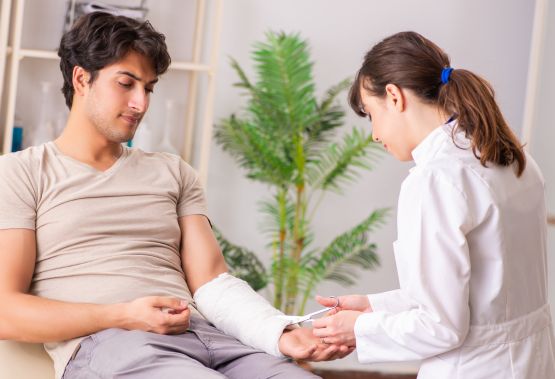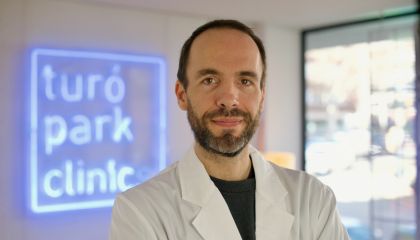A serious injury that requires urgent medical attention is referred to as trauma. Unexpected events like a fall or vehicle accidents can cause these injuries. Overusing a body part can also result in trauma. When faced with a traumatic event, it might be challenging to decide where to turn to for guidance, support, and healing.
At Turó Park Clinics, we understand the unexpected nature of traumatic experiences. Hence, when life challenges leave you feeling vulnerable, our dedicated team of traumatologists stands by your side to help you navigate the journey towards recovery.
Our wide-reaching traumatology department covers everything from pathologies to minor injuries and major trauma surgeries. So, whether you’ve experienced a sports-related injury, a workplace incident, or any other traumatic event, schedule a consultation with our traumatologist in Barcelona, and we will provide the care, guidance, and support you need to heal.
Life can take unexpected turns; when it does, we help make life better.
What’s Traumatology? Who is a Traumatologist?
Traumatology is a specialized medical and surgery branch focusing on understanding, diagnosing, and treating trauma and its consequences. This includes injuries, either present from birth (congenital) or acquired later in life due to tumors, infections, violent accidents, and other distressing events.
Traumatologists are experts who help people recover from such injuries and traumas. For instance, a general trauma surgeon in the hospital is the doctor you will most probably see in the emergency department after an accident. They identify and treat trauma and also take a proactive approach to prevent it and provide therapy (including rehabilitation).
Sometimes, traumatology is confused with orthopedics. While they share similarities, orthopedics studies and treats issues related to the musculoskeletal/ locomotor system (bones, ligaments, muscles, tendons, and nerves). In contrast, traumatology covers all injuries that are caused by trauma. This might be due to a vehicle accident, a sports injury (both high and low risk), falls, or even simple bruises. These injuries may also range from those affecting the skin's surface to deeper levels, such as the bones. In such cases, prompt medical attention is vital to address the trauma as effectively as possible.
Fast track your treatment
To book an appointment or speak with one of our friendly team, please get in touch using the options below.

What Is Traumatology Surgery?
Traumatology surgeries are emergency surgeries performed on patients with critical illnesses or injuries. It involves using both operative and non-operative management and is typically performed in an acute setting, fast-paced manner, with very little time for lengthy discussions.
Trauma surgeons have extensive knowledge of various surgical procedures and managing different injuries. At Turó Park Clinics, the surgery services carried out within the traumatology department include all kinds of interventions required to restore function and alleviate pain. The key areas offered, include:
- Prosthetic Surgery – Precision insertion of implants through minimally invasive techniques in patients with worn hip, knee, and shoulder joints due to the natural aging process, falls, or osteoarthritis.
- Arthroscopic Surgery – A modern surgery service that promotes rapid postoperative recovery, it involves introducing a camera through a small incision, along with other necessary tools that allow surgeons to visualize and repair internal joint structures (in the knee, shoulder, hip, and ankle) without the need for extensive open surgery.
- Surgery of Ligaments and Meniscus – Surgeries for ligament (anterior and posterior cruciate ligament) and meniscus tears to restore joint stability and function.
Our traumatologists in Barcelona work diligently to provide patients personalized care and treatment plans. They strive to ensure a thorough diagnostic process, discuss treatment options, and offer ample guidance through the surgical procedure and post-operative rehabilitation. Book a consultation now.
Different Types Of Traumatology
Traumatology is a diverse field that includes several subspecialties, each focusing on certain areas of treatment and expertise. These subspecialties are vital for providing specialized care to individuals.
- Pediatrics – Dedicated to addressing musculoskeletal disorders in infants, children, and adolescents.
- Sports Medicine – Focuses on preventing, evaluating, diagnosing, and treating injuries that athletes sustain during sports and physical activities.
- Knee Injury - Study, diagnose, treat, and monitor injuries affecting knee mobility.
10 Conditions A Traumatologist Can Treat
A traumatologist or an orthopedic traumatology expert deals with numerous injuries on a daily basis. Typically, the most common complaints tend to be about knee, shoulder, or foot pain. Nonetheless, bone fractures, dislocations, sprains, or arthritis are also common causes of trauma care.
Here are the 10 most common conditions treated by our traumatologist in Barcelona.
It is a degenerative joint condition characterized by the gradual breakdown of cartilage and other tissues within a joint. It is the most common type of arthritis in older people. Symptoms of osteoarthritis include joint pain, swelling near a joint, stiffness, and reduced mobility. Joints that are usually affected include the knees, hips, hands, neck, and lower back.
It is an inflammation or irritation of the tendons (thick cords that attach muscles to bones), often due to overuse, strain, too much exercise, injury, or infection. Patients usually experience pain and tenderness along the tendon, stiffness after prolonged rest, a grating or crackling sensation with movement or activity, etc. While tendinitis goes away on its own with time, a traumatologist will recommend medication and treatment to reduce pain and preserve mobility.
A break or crack in a bone due to fall, injury, overuse or repetitive motions, and even diseases that weaken the bone (pathologic fractures). Fractures can be partial cracks (hairline or greenstick fractures) or complete breaks (transverse, oblique, linear, or spiral). Depending on the severity, they might require casting, splinting, or surgery at a hospital.
Sprains occur when ligaments (strong, flexible fibers connecting bones) are stretched or torn. The ankle is the most common location for a sprain, but it can also happen at the wrist, knee, or thumb. Symptoms include rapid swelling and pain. As first aid, the RICE (Rest, Ice, Compression, Elevation) method should be used to relieve pain and swelling.
Lower back pain (LBP) is a very common condition that most individuals experience at some point in their lives. Causes of LBP can be spinal degeneration, muscle or ligament strain, arthritis, sciatica, or herniated or degenerated discs. A healthcare professional can better determine the cause and suggest the proper treatment.
Fibromyalgia is a chronic disorder that causes widespread musculoskeletal pain (throbbing, aching, or burning sensation). Other symptoms include headaches, poor sleep quality, fatigue, and irritable bowel syndrome (IBS). Anything from traumatic events to illness, repetitive injuries, anxiety, and genes can lead to fibromyalgia. Though the condition is primarily managed by rheumatologists, traumatologists assist in treating the associated musculoskeletal pain and discomfort.
It is a disease characterized by reduced bone mineral density and mass. Osteoporosis results in decreased bone strength and increases the risk of fractures. Prompt attention is vital to prevent further complications.
An excessive front-to-back curve of the spine or forward rounding of the upper is called kyphosis. The condition can occur at any age but mostly develops during adolescence due to poor posture (postural kyphosis), spinal features (congenital kyphosis), degenerative diseases, or injuries. One may not experience symptoms and might not need treatment at the early stages of kyphosis. However, if left untreated, the condition can worsen and lead to spinal deformity.
A condition where the cushioning discs between the spinal vertebrae bulge, protrude, or rupture, causing nerve compression. It can happen anywhere along the spine but is most commonly seen in the lower back. Causes include strain or injury, natural degeneration due to aging, or weakening of ligaments. People with herniated disks experience sharp pain on one side of the body, numbness in other parts, pain when moving the neck, etc.
Treatment is mandatory as it can otherwise lead to spinal cord or nerve compression, gradually leading to bladder or bowel function changes, edema, etc.
It is a common condition where the median nerve (a major nerve to the hand) is compressed or squeezed, causing pain and numbness in the arm and forearm. Carpal Tunnel Syndrome (CTS) might result from obesity, nerve-damaging conditions, medications, workplace factors, etc. Typically, there is no single major triggering factor. In most cases, CTS gets worse over time and thus should be treated early on.
Other Conditions Traumatologists Can Treat
- Muscle Spasms – Involuntary muscle contractions are caused by various factors, including muscle overuse or strain, dehydration, and nerve disorders.
- Bunions – Painful bony bumps that form at the base of the big toe.
- Meniscus injury – Torn meniscus (C-shaped cartilaginous discs in the knee joint) from forcefully turning or rotating your knee.
- Myelopathy – Spinal cord injury caused by severe compression that may, in turn, be a result of trauma, degenerative disease, herniation, etc.
- Spondyloarthrosis – A degenerative disorder that causes damage to the normal spine structure and function.
- Sacroiliac Joint Dysfunction – Improper movement of either one or both of two small joints that connect the sacrum to the pelvis.
If you suspect any of these conditions or something else that is making life difficult for you, reach out to us for prompt diagnosis and treatment.
Your health is our priority.
Take the first steps towards recovery with our traumatology services built on personalized care. Enjoy support and guidance tailored to your unique needs.

When Should You See A Traumatologist?
It is recommended to see a traumatologist if you experience pain in the bones, muscles, joints, or tendons. Consider the following warning signs or symptoms:
- Joint pain so severe that you can't move
- Unsuccessful treatment of joint pain or injury
- Previously diagnosed arthritis
- Sports injury with pain that lasts several days that seems to be getting worse
- A major or minor accident where pain in the affected area doesn’t go away
How To Start With Traumatology At Turó Park Clinics?
At our traumatology clinic in Barcelona, you will begin your journey with our expert by answering questions about your symptoms and undergoing necessary tests for proper diagnosis. This may include X-rays, CT scans, MRI, ultrasound, bone densitometry, or electromyography. The results of these tests are then used to make a proper diagnosis and put together an effective treatment plan.
Treatment approaches typically vary. Sometimes, all that’s needed is a bandage, splint, or cast. However, in more severe cases, surgical procedures may be required, involving using screws or plates to repair damaged areas. In such situations, patients might also undergo rehabilitation sessions to regain full mobility in the affected area.
Our traumatologist is experienced in diagnosing and treating disorders such as torn meniscus and ligaments, biceps pathology, sports injuries, osteoarthritis, and more. In addition, he is renowned for performing minimally invasive foot surgery, leveraging our traumatology hospital’s cutting-edge technology.
Book a consultation with our traumatologist in Barcelona today, and let us help you recover and regain your quality of life.
Our English-speaking traumatologist
